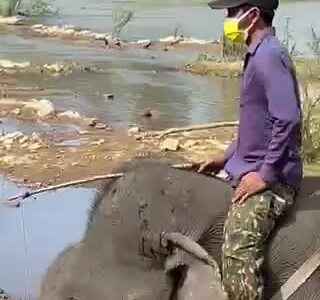A visitor to two tourism sites in the Central Highlands has accused them of abusing elephants they use to carry tourists around.
In a post in a Facebook group on Monday, Nguyen Ngoc A. said she visited Jun village in Buon Ma Thuot Town, Dak Lak Province, on Feb. 3.
There visitors can ride elephants to sightsee.
“Each [mahout] holds a rod that has a sharp iron spike on the side of the head to navigate and make the elephant obey. All the elephants at the site have injuries, both fresh and old.”
The next day she visited Cau Treo tourist area in Buon Don District and had the same experience: there were six elephants with bleeding injuries.
At Cau Treo, the mahouts had a string attached to the rod with a small rock, and “That could be the tool they caused the injuries with,” the post said.
Nguyen Ngoc A. has uploaded videos and photos of the elephants and their injuries.
 |
|
Photos of elephants at tourism sites in Dak Lak Province posted on Facebook by Nguyen Ngoc A. on February 4, 2022. |
She said the purpose of her post is to make visitors reconsider riding elephants, and hoped the tourist places would become more humane toward their elephants.
Y Gai Bya, 44, who lives in Buon Don District and owns and works with elephants at Cau Treo, said one of the elephants mentioned in the post belongs to his family but he does not ill-treat the animal as claimed by the tourist.
“My family has raised this elephant since 1983. We love it and consider it a family member.”
He claimed the injuries seen in the photos occurred when the elephant was in the forest by itself.
“One of its eyes does not function well anymore and when it moves around in the forest it might have scraped against some branches, resulting in the injuries.”
Tran Xuan Phuoc, director of the Elephant Conservation and Wildlife Rescue Center told VnExpress Wednesday that the center is verifying the accusations.
“All the images the tourist posted are real but many questions need to be answered. It is possible that the elephants were abused but there is no proof.”
During the latest Covid-19 wave, tourist sites in Dak Lak were closed for around nine months and their elephants were left to live on their own in the forest, he said.
Now that tourism has resumed, the elephants have been brought back, and trainers might have used the spike to retrain them after months of having them live in the wild, he speculated.
“Usually they control the elephants by speaking and hand gestures.”
A video posted on Facebook that captures the scene of tourists riding elephants at Cau Treo tourist site in Dak Lak Province, February 4, 2022.
Dak Lak, home to the country’s largest elephant population, signed an agreement with Hong Kong-based animal welfare organization Animals Asia last December to phase out the elephant-riding tourism industry along with some other activities that badly affect the well-being of domesticated elephants.
It will instead offer elephant-friendly tourism services to conserve the animals whose population has shrunk by 90 percent in the last four decades.
In 1990 the province had more than 500 elephants, but now only 140 are left, mainly in Buon Don and Lak districts.
For many years Dak Lak has been famed for its elephant-back tours and tourists could also watch elephants swim, play football and parade, but activists describe these as “exploitation.”
- Reduce Hair Loss with PURA D’OR Gold Label Shampoo
- Castor Oil Has Made a “Huge” Difference With Hair and Brow Growth
- Excessive hair loss in men: Signs of illness that cannot be subjective
- Dịch Vụ SEO Website ở Los Angeles, CA: đưa trang web doanh nghiệp bạn lên top Google
- Nails Salon Sierra Madre
 VnExpress News The News Gateway of Vietnam
VnExpress News The News Gateway of Vietnam






